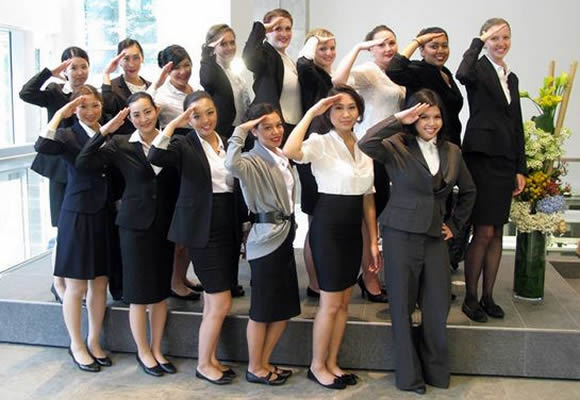
How to Become a Flight Attendant

Take to the skies! Find out what it takes to become a flight attendant.
Becoming a flight attendant means visiting new and exciting locales and being paid to see the world from a workplace 30,000 feet in the sky. It also means being physically and mentally fit, patient and reassuring to a fault and being prepared for every possible in-flight scenario.
“Being a flight attendant is a lifestyle as much as it is a career,” says Canadian Tourism College (CTC) instructor Julia Socher, “and it’s one that is filled with endless possibilities and adventures.”
Socher teaches CTC’s Flight Attendant Pre-Employment diploma program. The 12-week program provides a comprehensive introduction to flight attendant skills training and theory, with a focus on developing a professional image.
“The Flight Attendant position remains one of the most sought-after jobs in the world,” says Socher. “Competition is tough & an interviewee needs to stand out above the thousands that may apply for one position.”
Students are prepared for the interview and recruitment process that flight attendants go through, including a medical examination and initial training. Once students pass the interview process, the airline they’ve been accepted by will provide them with another 4-8 weeks of training, including possible on-line courses.
What does a flight attendant do?
The main role of a flight attendant is safety.. the training consists of roughly 90% safety training and only 10% customer service.
Julia Socher
The old stereotype of the giggly stewardess who asks, “Coffee or tea?” is a thing of the past. Flight attendants are briefed on weather conditions, possible turbulence, flight duration and any other important details related to the upcoming flight. Before take-off, they check the aircraft and make sure that all of the safety equipment is working properly, and that accommodations have been met for any special needs travellers. As the passengers board, they keep a keen eye out for suspicious behaviour or any potential dangers.
“The main role of a flight attendant is safety,” Socher stresses, “which is why, in general, the training consists of roughly 90% safety training and only 10% customer service. All flight attendants must be qualified in Aviation First Aid, cabin fire-fighting and emergency procedures for both land and water emergencies and evacuations.”
Flight attendants must also be prepared to handle fuel threats, fires, blocked exit procedures, decompressions, life raft procedures—the list goes on. While ensuring passenger comfort is essential, it’s ensuring passenger safety that’s the number one priority.
CTC’s Pre-Employment program offers First Aid training done by Red Cross or St John’s Ambulance, as well as certificates in Foodsafe, Serving It Right, Leadership training and Assisting Travellers with Disabilities.
The important, life-saving role of the flight attendant has gotten increased recognition in the past decade or so. The quick-thinking and calmness of flight attendants on United Flight 232, which pilots landed after losing all flight controls, was credited by the 185 survivors. The same is true of the passengers on US Airways Flight 1549, which did an emergency water landing on the Hudson River, and Asiana Airlines Flight 214, which crashed on final approach at San Francisco International Airport.
Statistically, air travel is still the safest way to travel. The above are examples of the kind of urgent situations that a flight attendant must be prepared to face – yet luckily, very rarely has to!
Is this the right career for you?
“Airlines look for customer service experience, outgoing personalities, ability to follow strict rules and regulations, as well as the willingness to relocate to different cities,” says Socher. “Fluency in additional languages is also an asset.” To that end, CTC offers a Rosetta Stone language course to enable the student to improve their skills in this area.
Because of the physical and psychological rigors of the job, prospective flight attendants need to prove to airlines that they’re up for the job. Traveling through time zones, long and irregular workdays and fatigue are among the factors to be considered.
“Initial training with each airline is governed by Transport Canada and Canadian Aviation Regulations,” she says, “therefore training is intense, and every flight attendant has to qualify annually in order to be competent and continue flying each year.”
Socher also wants to dismiss any lingering notion that this is a career meant only for women.
“The position of flight attendant is generally viewed as more of a female role, though in actuality there is a strong presence of males in the industry,” she says. “Many years ago, men were hired as pursers and women were hired as ‘stewardesses’ or ‘air hostesses’. With gender equality now firmly in place … the term flight attendant was implemented and refers to both male and female.”
Some advice for prospective students
Socher has some words of wisdom for those who are interested in becoming flight attendants.
“Research airlines and find out if they are currently or will be recruiting in the near future,” she says. “Make sure you have the necessary citizenship and immigration documents required for that specific airline. Reconsider before getting a tattoo: visible ones are no-no’s for most airlines!”
Also, she suggests enrolling in a program like CTC’s Flight Attendant Pre-Employment diploma program, which focuses on developing the skills, confidence and image that airline recruiters look for. It is, she says, “a job based on qualifications and skills a person has achieved on a personal basis,” so honing your personal, social and communications skills increases the chances of being selected for training by an airline.
But mostly, Socher advises students to look forward to a really great career.
“It’s a wonderful career and lifestyle, so take a risk and find out for yourself what flying is all about,” she says. “Discover how small the world really is and what exciting people, places and different cultures are there to be discovered. After securing the job and passing your probation period, most airlines offer free or reduced rate travel for employees and their families—often friends may benefit as well. The perks and travel benefits can be amazing, and that’s why so many people want to get in to this industry!”
Canadian Tourism College’s Flight Attendant Pre-Employment diploma program is available at both their Vancouver and Surrey campuses.


Leave a Reply